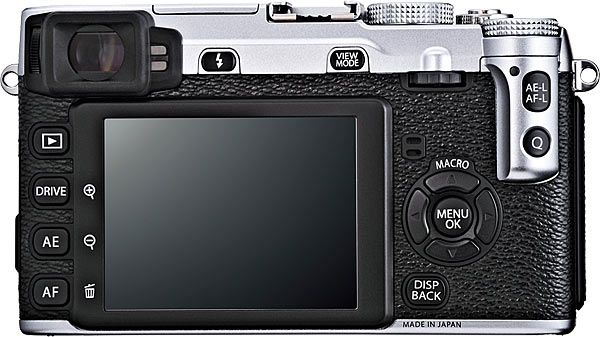Review Date: August 12, 2013
Category: Serious to Advanced Amateur


Photoxels Gold Award – Enthusiast Mirrorless Interchangeable Lens Camera
HANDLING & FEEL
The Fujifilm X-E1 continues the retro rangefinder look that is so beautifully designed. Build quality is very good with a quality and precise feel to all the controls. It is beautifully finished and is available in an all-black profesional-looking body or a stunning black/silver version.
The Fujifilm X-E1 is smaller (by about 10.5mm in width, 6.9mm in height and 4.2mm in depth) and approx. 100g lighter than the X-PRO1. You will find it more comfortable carrying the X-E1 using the shoulder strap.
For this review, I received the black/silver X-E1, the XF27mmF2.8 pancake lens and the XF55-200mmF3.5-4.8 R LM OIS telephoto zoom lens.
Here is a comparison of the sizes of the X-E1 compared to the X-PRO1, comparisons courtesy of camerasize.com:



OLED Electronic Viewfinder
To save on the size, weight and cost of producing the X-E1, the Hybrid (optical/electronic) Multi Viewfinder of the X-PRO1 has been replaced with a 0.5-in., very high resolution (approx. 2,360,000-dot) OLED color viewfinder on the X-E1. It retains the eye sensor that automatically switches the view to the viewfinder or LCD, and adds a diopter dial.
There is a Distance Indicator overlay at the botton of the screen that displays in Manual Focus (MF) mode and in Custom Display mode. In MF mode, the Distance Indicator also indicates the depth of field (DOF) you will obtain with the selected aperture. You can also press the Fn button (if set to DOF) to stop down the aperture for a visual check of the DOF.
To select the AF area, you press the AF button (bottom left of the LCD screen) and use the Selector (ARROW Keys) to navigate the screen. You can select 7 x 7 = 49 AF areas using the LCD/EVF. A nice touch: you can wrap around as you navigate top/bottom and right/left (i.e. when you reach the edge, you wrap around to the other edge) and quickly return to center by pressing the Menu/OK button. In Single Focus mode, you can use the Command Dial to vary the size of the AF area.
In MF mode, click the AF-L button to do a quick autofocus (One-Touch AF), click the Command Dial to magnify the selected focus area, then rotate the MF ring to fine tune the focus. If Focus Peaking is set [MENU – SHOOTING MENU 5 – MF ASSIST – FOCUS PEAK HIGHLIGHT], the edges will glow black/white to help you find focus.
TIP: The camera remembers your AF area even when you turn it off so you may want to get into the habit of recentering it before switching the camera off. Press the Menu/OK button to quickly return to center.
The front of the camera has a clean design with the AF-assist Illuminator/Self-Timer lamp, the Lens Release Button on the left of the mount and the Focus Mode Selector on the right. Here, we see the pop-up flash extended. Set to Commander mode, the pop-up flash can control optional remote flash units. When an external flash is mounted onto the hot shoe, you won’t be able to pop-up the built-in flash. The X-E1 has just a hint of a handgrip but the latter works quite well.
TIP: For those with bigger hands, there is an optional and larger Hand Grip HG-XE1 (B&H, Adorama, Amazon.com
) that attaches to the bottom of the camera.

The top of the camera is also refreshingly clean. Viewing from the back, there’s the Shutter Release button with the Power ON/OFF Switch around it; it is threaded to accept an optional wired cable release, useful when using very slow shutter speeds. To its left is the Shutter Speed Dial which goes from B, T, 1/4 sec. to 1/4000 sec., plus A (which stands for "Automatic").
TIP: You can select a shutter speed that is between two numbers on the dial. For example, to access shutter speeds between 1/4 sec. and 1/8 sec., set the Shutter Speed Dial to 1/4, then use the RIGHT and LEFT ARROW on the Selector to select shutter speeds between 1/2.5 sec. to 1/6 sec.
TIP: To access shutter speeds lower than 1/4 sec., set the Shutter Speed Dial to T, then use the RIGHT and LEFT ARROW on the Selector to select shutter speeds between 1/2 sec. to 30 sec.
Bulb (B) allows you to open the shutter for up to 60 minutes. You would want to use a remote wired cable release to avoid camera shake.
Note that though A, S, and M shooting modes give you access to the full range of shutter speed from 30 sec. to 1/4000 sec., P mode unfortunately accesses only 1/4 sec. to 1/4000 sec.
The X-E1 has Program Shift in P mode. To go into P mode, set both the Shutter Speed dial and Aperture Ring to “A”. (If you are using a lens that does not feature an aperture ring, rotate the Command Dial until P displays on screen.) Then, use the RIGHT and LEFT ARROW on the Selector to Program Shift.
TIP: Program Shift is available in P mode only when a non-AUTO ISO is selected.
To the right of the Shutter Release button is the customizable Fn button. You can change its functionality in the Menu [SHOOTING MENU 3 – FUNCTION (Fn) SETTING – Fn Button]. You can set Fn to one of the following: Multiple Exposure, DOF, ISO, Self-timer [is reset when you turn off the camera], Image Size, Image Quality, Dynamic Range, Film Simulation, White Balance, AF Mode, Select Custom Setting, Movie, RAW, Focus Area, and Aperture Settings.
Tip: Press and hold the Fn button for about 2 seconds to immediately enter the Customize Fn Button screen.
Many of these function can also be displayed on the Control Info screen. Press the Q (Quick Menu) button on the back to display the Control Info screen, select using the Selector and set using the Command Dial.
To the right and behind the Shutter Release button is the Exposure Compensation Dial. The dial is easy enough to rotate with your thumb but stiff enough that you won’t inadvertently move it during use. However, it is easy to change it inadvertently when you pick up the camera or put it away, so it’s always a good idea to get into the habit of checking it.
To the left of the Shutter Speed Dial is the hotshoe (that will accept an external speedlight) and the pop-up flash (which we see here closed and flush with the top plate).

On the back we have a 2.8-in. LCD with 460k-dot resolution. The LCD is not tiltable or touchscreen. It does its job though there’s nothing to write home about. On the right side of the LCD are the Command Dial, Selector (not “Multi” since only Macro is available), DISP/BACK button, AE-L/AF-L button, and Q button.
TIP: Press and hold the DISP/BACK button for about 3 seconds to immediately switch to SILENT MODE: all operational sounds are turned off and the AF Assist light and flash are disabled. Unfortunately, the shutter, being mechanical, will always make a noise.
TIP: It’s unmarked but the DOWN ARROW on the Selector is a customizable Function button. [SHOOTING MENU 3 – FUNCTION (Fn) SETTING – SELECTOR – same selection as for the Fn button.]
There are 4 buttons on the left side of the LCD: PLAYBACK, Drive/PLAYBACK ZOOM IN, AE (Photometry, i.e. metering options: Multi, Spot, Average)/PLAYBACK ZOOM OUT and AF (AF area selection, if AF Mode is set to Area in the Menu: MENU – SHOOTING MENU 4 – AF MODE – AREA)/DELETE.
Above the LCD is the View Mode (Eye Sensor, LCD OFF, LCD ON). A Diopter adjustment dial is to the left and the Eye Sensor to the right that will automatically switch the view between the EVF and LCD as you bring your eye to, and remove your eye from, the EVF.
The tripod mount at the bottom of the camera is not inline with the center of the lens and you won’t be able to change batteries/SD card with the camera mounted on a tripod.
Included in the box is a rechargeable Li-ion battery NP-W126 that can take about 350 shots on a fresh charge. A battery charger BC-W126 recharges a depleted battery in approx. 150 min.
The Fujifilm X-E1 uses the SD / SDHC / SDXC memory card.
The Fujifilm X-E1 handles extremely well whether with the XF27mm, XF35mm or XF55-200mm lens attached. I thoroughly enjoyed using it, especially the dedicated Shutter Speed dial and Aperture Ring. Even though I love my X-PRO1, if I had to choose betwen the two today, the smaller and lighter size of the X-E1 would tilt my decision toward it. Paired with the XF27mmF2.8, it’s a compact and inobtrusive camera, great for street photography.
Next: Fujifilm X-E1 User’s Experience
Related Links:




















